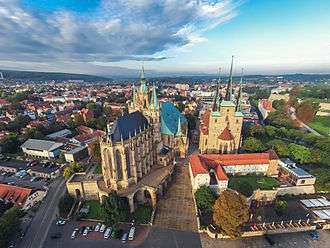Erfurt Cathedral
Erfurt Cathedral (German: Erfurter Dom, officially Hohe Domkirche St. Marien zu Erfurt[1], English: Cathedral Church of St Mary at Erfurt), also known as St Mary's Cathedral, is the largest and oldest church building in the Thuringian city of Erfurt, central Germany. It is the episcopal seat of the Roman Catholic Diocese of Erfurt. The cathedral was mainly built in the International Gothic style and is located on a hillside overlooking the main town square (Domplatz, Cathedral Square).[2] Former German names include Marienkirche and Propsteikirche Beatae Mariae Virginis.
| Erfurt Cathedral | |
|---|---|
| Cathedral Church of St Mary at Erfurt | |
| |
 Erfurt Cathedral (left) and St Severus's Church (right) | |
 Erfurt Cathedral Location in Germany | |
| 50°58′33″N 11°01′24″E | |
| Location | Erfurt, Thuringia |
| Country | Germany |
| Denomination | Roman Catholic |
| Website | www |
| History | |
| Status | Cathedral |
| Dedication | St Mary |
| Architecture | |
| Functional status | Active |
| Style | Gothic |
| Groundbreaking | 12th century |
| Specifications | |
| Height | 81.26 m (266 ft 7 in) |
| Bells | 14 |
| Tenor bell weight | 11.45 t (11.27 long tons) |
| Administration | |
| Diocese | Diocese of Erfurt |
| Clergy | |
| Provost | Gregor Arndt |
| Vicar(s) | Bernhard Drapatz |
| Deacon(s) | Matthias Burkert |
| Laity | |
| Organist(s) | Silvius von Kessel |
History
The site of the present cathedral has been the location of many other Christian buildings, for example a Romanesque basilica and a church hall. In 742, Saint Boniface erected a church on the mound where Erfurt Cathedral is now sited. In the mid-12th century, the foundations of the original church were used for a Romanesque basilica. In the early 14th century, the mound was enlarged to make room for St Mary's Cathedral.[3]
Martin Luther was ordained in the cathedral on 3 April 1507.[4]
Architecture
The architecture of Erfurt Cathedral is mainly Gothic and originates from the 14th and 15th centuries. The building has many notable architectural features, including the stained glass windows and the interior furnishings. The central spire of the cathedral's three towers houses the Maria Gloriosa which, at the time of its casting by Geert van Wou in 1497, was the world's largest free-swinging bell. It is the largest surviving medieval bell in the world. It is known for the purity of its tone.
Relics and treasures
The cathedral houses many rare and rich furnishings and sculptures, including the tomb of the bigamous Count von Gleichen, accompanied by both of his wives, a stucco altar, a bronze candelabra of Romanesque antiquity called Wolfram, the oldest free standing cast work in Germany, and, out on the porch, several statues of the Wise and Foolish Virgins.
 The altar
The altar The Wise and Foolish Virgins
The Wise and Foolish Virgins Wolfram candelabra
Wolfram candelabra
Bells
| No. |
Name |
Year |
Caster |
Diameter (mm) |
Mass (kg) |
Strike tone (HT−1/16) |
Bell location |
| 1 | Gloriosa | 1497 | Gerhardus de Wou, Erfurt | 2,560 | 11,450 | e0 +3 | Middle Tower, lower |
| 2 | Dreifaltigkeit | 1721 | Nicolaus Jonas Sorber | 1,940 | 4,900 | g0 +12 | North tower |
| 3 | Joseph | 1961 | Glockengießerei Schilling, Apolda | 1,840 | 4,600 | a0 +8 | South Tower |
| 4 | Andreas | 1961 | Glockengießerei Schilling, Apolda | 1,540 | 2,600 | c1 +11 | North Tower |
| 5 | Christophorus | 1961 | Glockengießerei Schilling, Apolda | 1,360 | 1,900 | d1 +10 | South Tower |
| 6 | Johannes Baptist | 1720 | Nicolaus Jonas Sorber | 1,190 | 1,000 | e1 +7 | |
| 7 | Cosmas und Damian | 1625 | Jakob König, Erfurt | 750 | 200 | des2 | Middle Tower, upper |
| 8 | Cantabona | 1492 | Hans Sinderam | 650 | 300 | g2 | |
| 9 | Engelchen | about 1475 | Claus von Mühlhausen, Erfurt | 550 | 125 | as2 | |
| 10 | Namenlose | 1475 | Meister Peter | 500 | 75 | b2 | |
| 11 | Wandlungsglocke | 1961 | Glockengießerei Schilling, Apolda | 550 | 100 | f2 | Dachreiter (Hochchor) |
| 12 | Paulusglocke | 2009 | Br. Michael Reuter, Maria Laach | 390 | 42 | d3 | |
| I | Martha | 1961 | Glockengießerei Schilling, Apolda | e2 | Lantern | ||
| II | Elisabeth | 1961 | Glockengießerei Schilling, Apolda | gis2 |
References
- Official website, retrieved 15 June 2018
- Stade, Heinz, et al. (2015) Erfurt: eine Stadt in Wandel, Leipzig: Edition Leipzig
- Christoph Engels, (2010) '1000 Sacred Places', Tandem Verlag GmbH, p 55
- Lull, Timothy, Nelson, Derek (2015) Resilient Reformer: The life and thought of Martin Luther, Minneapolis: Augsburg Fortress
External links

- Official website
